Is a .30 caliber airgun REALLY deadlier than a .25? (SURPRISING RESULTS!)
Hi everybody. I’m Donnie Reed from Baker Airguns, and I’m probably about to make a lot of you angry. Please keep in mind that your hostility should not be directed at me, but rather at the laws of physics. I am not in charge of the laws of physics. I just study them to learn more about what is REALLY going on here in the world. I’m absolutely obsessed with that question, which is why I studied physics in the first place. It’s also why I raised the question to myself, “Which pellet will penetrate further? A 33.95gr .25 caliber pellet at 70ft-lbs, or a 44.75gr .30 caliber pellet at 70ft-lbs?” That question is what this article is all about, and the results might surprise you. I’m going to have to talk a little physics, but I’ll keep it very basic and not too “mathy.” For all of the readers out there educated in physics, please forgive how much I’m leaving out. I want anyone to be able to understand this, even if they’ve never studied physics at all. The link below is to the video that accompanies this article. I suggest taking them both in for the full story.
There is A LOT that goes into terminal ballistics. What in the world is “terminal ballistics” anyway? As defined by Wikipedia, “Terminal ballistics is a sub-field of ballistics and refers to the behavior and effects of a projectile when it hits and transfers its energy to a target.” It’s basically the study of what happens when a projectile hits something, and it’s messy. There are a lot of factors to be considered. First would be the energy that the projectile carries. This is referred to as “kinetic energy.” The equation for kinetic energy is, K.E. = 1/2 m v2
In English, that equation says kinetic energy equals one-half of the mass of the projectile multiplied by the velocity squared. In our gun world, we modify this equation slightly and we get foot-pounds of energy out of the equation. Most of us are familiar with this. For the purpose of this test, the kinetic energy of the .25 and the .30 was almost exactly the same. I used two FX Impacts for this test. The .25 averaged 965fps with a 33.95gr pellet, and the .30 averaged 843fps with a 44.75gr pellet.The .25 averaged 70.21ft-lbs and the .30 averaged 70.63ft-lbs. The .30 has a slight edge here, but not enough to really matter.
Another factor to consider is momentum. The equation for momentum is mass times velocity. For simplicity, let’s forget about proper units. Using my arbitrary units I’ll call “momentums”, the .25 has 32,761 momentums and the .30 has 37,724 momentums. Basically, the .30 has more momentum in this test than the .25 does. Again, the .30 has the edge here.
Now we have to consider inertia. Inertia is the tendency of an object to resist a change in speed or direction. This is controlled entirely by the mass of the object. The more mass it has, the more inertia it has. The .25 caliber pellets used for this test were JSB King Heavy MkII 33.95gr pellets. The .30 caliber pellets used for this test were the JSB Exact 44.75gr pellets. Yet again, the .30 has more mass, more inertia, and has the edge in this category as well.
Stick with me. We’re almost to the good stuff.
Animals are mostly water. In fact, most animals average between 70%-75% water. Because of this, ballisticians use ballistics gel to quantify projectile performance. Ballistics gel is basically water mixed with protein. This simulates animal tissue. Since we’re dealing with water, the force of drag becomes a major factor in terminal ballistics. Drag is, more or less, how hard the target pushes back against the projectile. The more drag there is, the sooner the projectile will stop. Here is the equation for drag force…
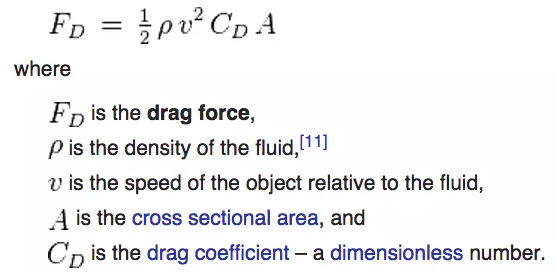
For our purposes, we can negate the 1/2 fluid density, as both guns were shot into the same medium. I used two 4″x4″x18″ blocks of Clear Ballistics 10% calibrated ballistics gel for the test. The important parts to us are the velocity, the cross sectional area, and the drag coefficient. This is where my suspicions came from. While the .25 has a higher velocity (+123fps), it has a much lower cross sectional area. The .25 is 31.65mm squared and the .30 is 45.58mm squared. The .25 also has a better drag coefficient. This fact gnawed at me, and I just had to test it to see what would happen.
Ok, that’s all the physics I want to discuss. Thank you for sticking with me through all of that, but the preamble was necessary. I left a lot out and simplified quite a bit, but like I said….I want that part of this article to be easily digested. If any of my fellow physics nerds want to discuss this in depth and using proper units, message me or comment and I’d be happy to oblige.
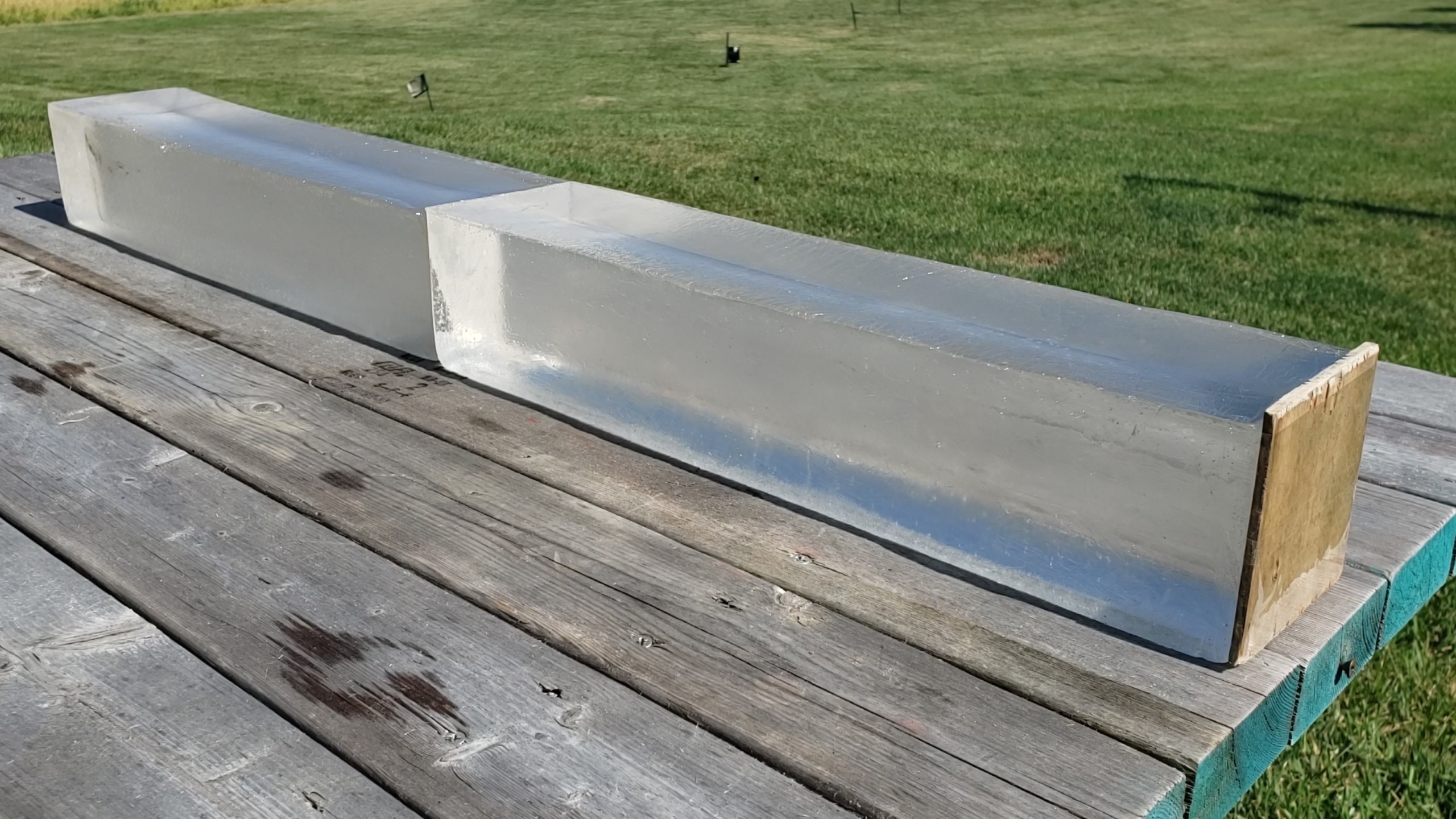
Now….onto the good stuff. As I said earlier, I used two FX Impacts for this test. One in .25 caliber and one in .30 caliber. I used the JSB King Heavy MkII 33.95gr pellets in the .25 and the JSB Exact 44.75gr pellets in the .30. Do remember that both of these guns were set to almost exactly 70ft-lbs, with a slight edge going to the .30. All shots were taken at precisely 20 yards. For the first test, I placed two 18″ blocks of ballistics gel end to end…essentially making a 36″ long block. In front of the first block, I taped a piece of 4.5mm thick plywood using packing tape. This was to simulate skull. We’ll refer to this as the “hard target” or “head shot” test. I took five shots with each gun at 20yds. These are the results…
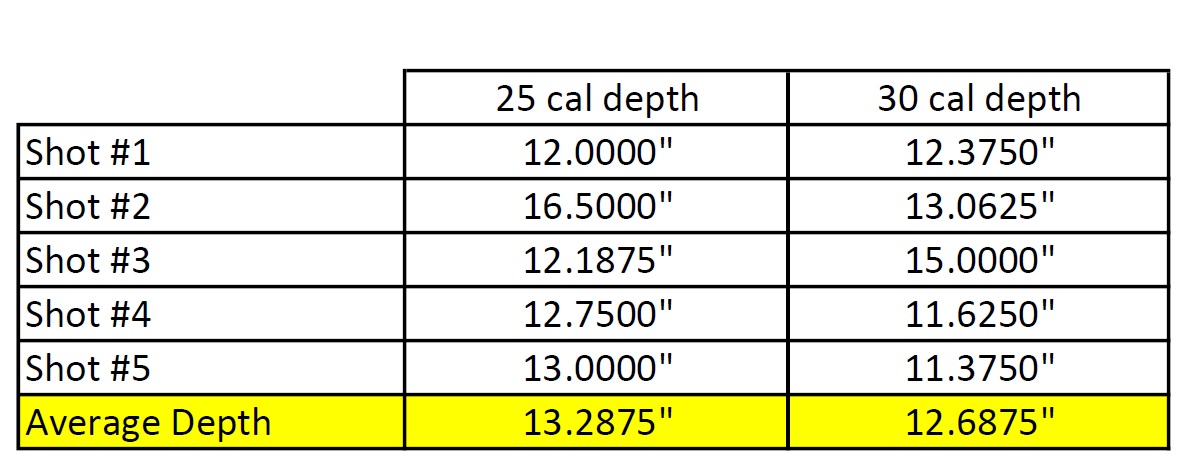
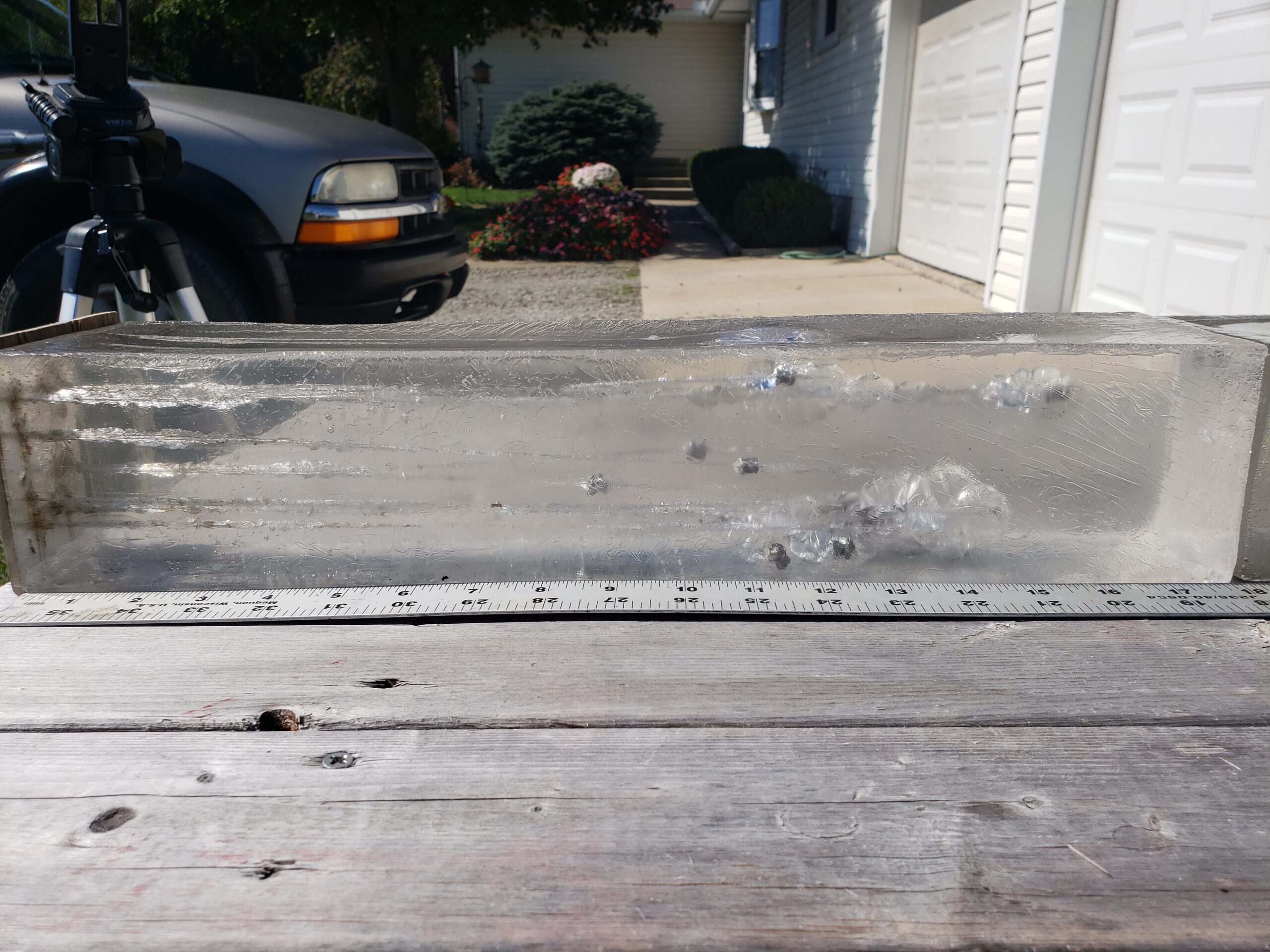
Well surprise, surprise, surprise! The .25 out penetrated the .30 in the hard target (head shot) test. Honestly, did you see that coming? The .25 averaged 13.2875″ and the .30 averaged 12.6875″ of penetration after passing through the 4.5mm piece of plywood “skull.” That’s a difference of 0.6″ (about 5/8 of an inch) on average. What’s more is that the deepest shot of all was with the .25 at 16.5″ of penetration. The winner of the hard target (head shot) test is unquestionably the .25 caliber.
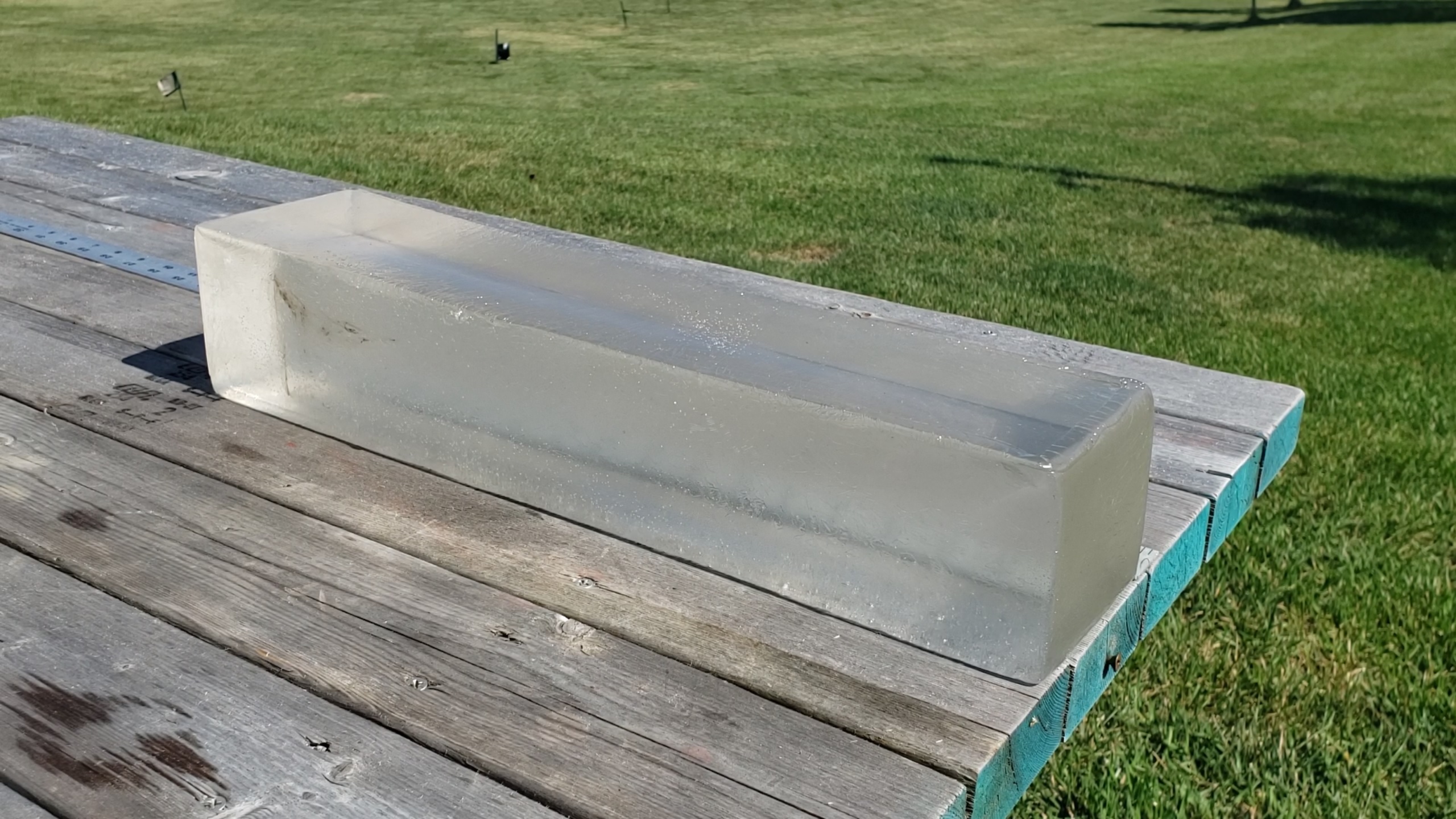
Now, I know what you’re thinking. You’re thinking that the plywood is what made the difference. You’re thinking that the larger cross sectional area of the .30 caliber pellet lost more energy on it’s way through the plywood than the smaller .25 caliber pellet did. Am I right? Not to worry. I did a soft target test as well. For this test, I simply used the untouched gel block I had left over with nothing at all in front of it. I took three shots with each gun into the bare gel at 20 yards. These are the results…

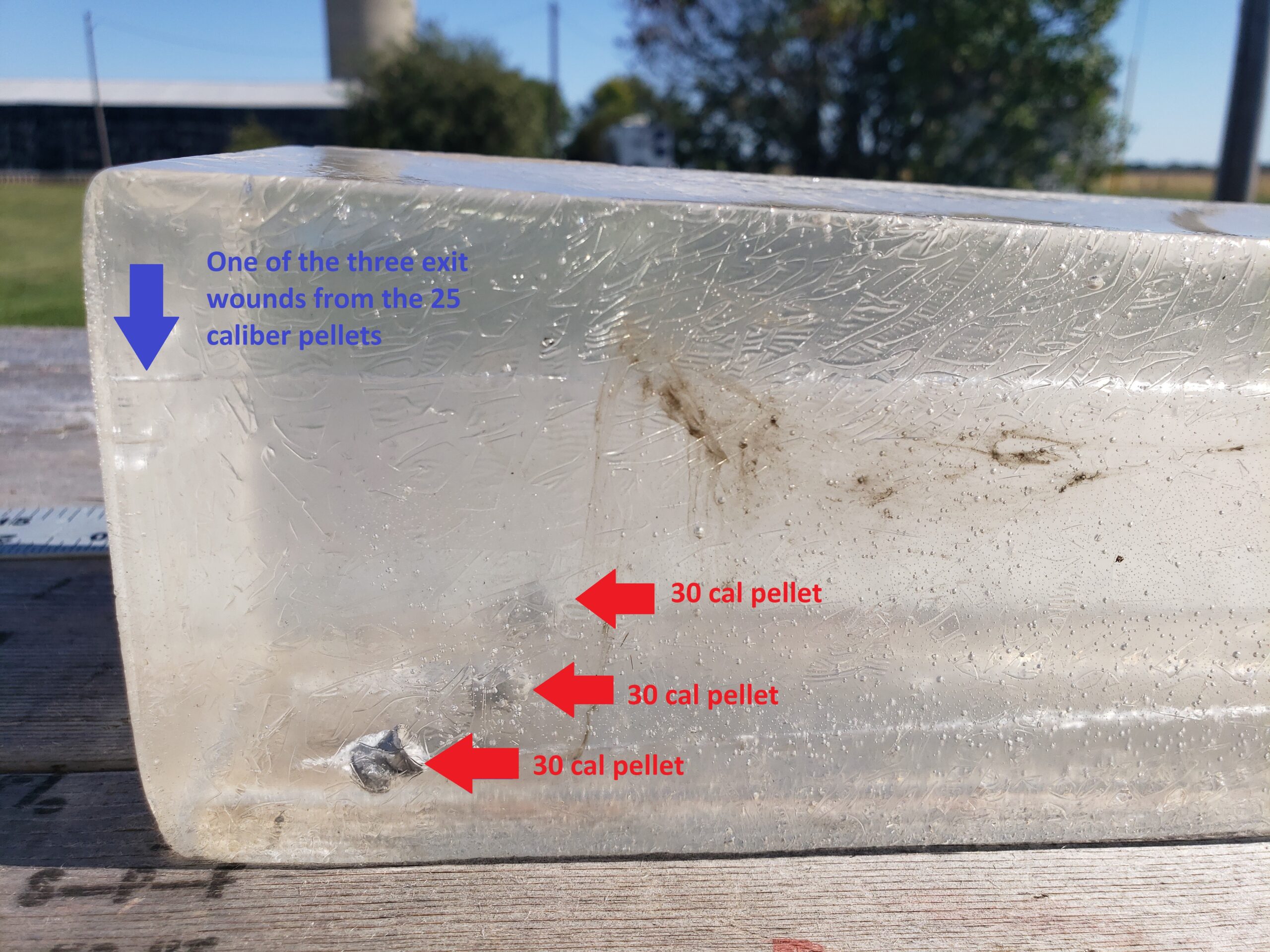
There you have it. I think this test puts the proverbial “nail in the coffin” concerning this issue. The .25 caliber again out penetrated the .30 caliber. Unfortunately, I don’t know by exactly how much this time. The three .25 caliber pellets went clear through the 18″ of gel. The average depth of the .30 caliber pellets was 17.1875″. Clearly, the .25 penetrated at least an inch further than the .30. The .25 caliber is the clear overall winner of this test. Plain and simple, at the same energy level and using these exact pellets, the .25 WILL out penetrate the .30 caliber.
So what does this mean to you? Does it mean that the .25 is deadlier than the .30? In certain situations, perhaps it is. Think of hunting hog with their thick, hard skulls. Due to the results of this test, I would be inclined to say that a high powered .25 caliber might be a better choice than a .30 caliber of the same energy level. This is not to say that the .30 caliber is a puny weakling of an airgun. It is certainly not. The .30 caliber is usually capable of higher energy levels than a .25 to begin with. Perhaps with a .30 at 80ft-lbs, it would indeed out penetrate a .25 caliber at 70ft-lbs. I don’t know, as I’ve not done this test under those conditions. They are both very deadly airguns….but when comparing apples to apples…the .25 caliber WILL out penetrate the .30 caliber. You are free to use this information however you choose.

Donnie Reed is our Sales/Product Manager and general airgun guru here at Baker Airguns. He was a member of the U.S. Marine Corps, and qualified as both a Rifle Expert and Pistol Expert. Donnie is now a competitive airgun shooter, focusing primarily on field target and benchrest competitions. He has won both PCP and piston class field target matches, as well as local benchrest competitions. Donnie also runs the Youtube channel and Facebook group ALL THINGS AIRGUN. His first college degree is in Mathematics and Sciences, but he is still pursuing another in Physics and Astronomy.

